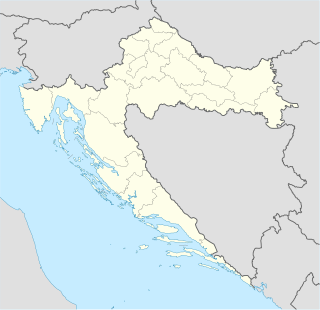
Operation Hurricane-91 was a military offensive undertaken by the Croatian Army against the Yugoslav People's Army and SAO Western Slavonia Territorial Defense Forces in the Sava River valley, in the region of Western Slavonia during the Croatian War of Independence. The operation began on 29 October 1991 and ended on 3 January 1992 when a nationwide ceasefire was signed to implement the Vance plan. The offensive was aimed at recapturing the region, in conjunction with two other HV offensives launched against SAO Western Slavonia in the north of the region within days.
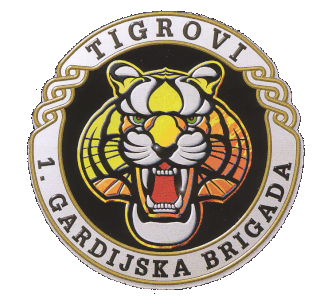
Croatia's First Mechanized Guard Brigade - named "The Tigers" - was the most elite and best equipped military brigade of the Croatian Army. Its military base and headquarters was in the Croatian capital of Zagreb, origin of most of the brigade's personnel. In 2008, as part of a larger military restructuring, the brigade-sized unit was disbanded and reformed as a battalion of the Motorized Guard Brigade.

The Battle of the Barracks was a series of engagements that occurred in mid-to-late 1991 between the Croatian National Guard and the Croatian police on one side and the Yugoslav People's Army on another. The battle took place around numerous JNA posts in Croatia, starting when Croatian forces blockaded the JNA barracks, weapons storage depots and other facilities. It formally began on 14 September; its objective was to neutralise the JNA positions in ZNG-held territory and to secure arms and ammunition supplies for the poorly equipped ZNG.

The Croatian National Guard was an armed force established by Croatia in April and May 1991 during the Croatian War of Independence. Although it was established within the framework of the Ministry of the Interior for legal reasons, the ZNG was under the direct command of the Ministry of Defence. It was tasked with the protection of Croatia's borders and territory, and with tasks normally associated with police forces. The ZNG was formed with the transfer of special police units to the ZNG, establishing four all-professional brigades in May 1991, and was presented to the public in a military parade in Zagreb on 28 May. It was commanded by Defence Minister General Martin Špegelj before his resignation in early August. Špegelj was replaced by General Anton Tus, who became the first head of the General Staff of the Armed Forces of the Republic of Croatia.

The Battle of Zadar was a military engagement between the Yugoslav People's Army, supported by the Croatian Serb Serbian Autonomous Oblast of Krajina, and the Croatian National Guard, supported by the Croatian Police. The battle was fought north and east of the city of Zadar, Croatia, in the second half of September and early October 1991 during the Croatian War of Independence. Although the JNA's initial orders were to lift the Croatian siege of the JNA's barracks in the city and isolate the region of Dalmatia from the rest of Croatia, the orders were amended during the battle to include capturing the Port of Zadar in the city centre. The JNA's advance was supported by the Yugoslav Air Force and Navy.

Operation Whirlwind was a failed Croatian Army (HV) offensive in the Banovina region of Croatia, fought from 11–13 December 1991, during the early stages of the Croatian War of Independence. The offensive employed a single infantry brigade as the main attacking force, supported by a bridging unit and a handful of tanks and armoured personnel carriers. Although the offensive met hardly any resistance in its initial stage, achieving tactical surprise, the operation was poorly planned, supported and executed as a result of limited training and combat experience. The offensive established a short-lived bridgehead, evacuated in panic two days after the operation commenced, under tank and mortar fire from the Yugoslav People's Army (JNA) deployed north of Glina.

The Battle of Gospić was fought in the environs of Gospić, Croatia, from 29 August until 22 September 1991 during the Croatian War of Independence. The battle pitted the Yugoslav People's Army (JNA), stationed in five barracks in the town, and paramilitary elements of the Serbian Guard against the Croatian National Guard (ZNG), police forces based in Gospić and police reinforcements from elsewhere in Croatia. Fighting in the eastern districts of Gospić, controlled by JNA forces with supporting artillery, was largely static but the balance shifted in favor of the Croatian forces following the capture of several JNA depots and barracks on 14 September. The remaining barracks were captured by 20 September leading to the expulsion of the JNA and Serbian Guard forces from the town.

The Battle of Šibenik, also known as the September War, was an armed conflict fought between the Yugoslav People's Army, supported by the Croatian Serb-established Serbian Autonomous Oblast of Krajina, and the Croatian National Guard, supported by the Croatian Police. The battle was fought to the north and west of the city of Šibenik, Croatia on 16–22 September 1991, during the Croatian War of Independence. The JNA's initial orders were to relieve Croatian siege of their barracks in the city and isolate the region of Dalmatia from the rest of Croatia. The JNA's advance was supported by the Yugoslav Air Force and the Yugoslav Navy.
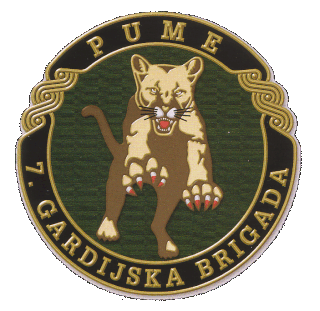
The 7th Guards Brigade, also known by their nickname Pumas, was a Croatian Ground Army (HV) brigade formed on 23 December 1992 in Varaždin. The brigade was initially formed out of the 5th Battalion of the 1st "Tigers" Brigade and its first commander was Ivan Korade, who led the unit during the War of Independence (1991–95).
The 3rd Guards Brigade "Kune", was a Croatian Army guards brigade formed on 29 April 1991 in Vinkovci, Eastern Croatia. During the Croatian War of Independence, the 3rd Guards Brigade primarily operated in the regions of Slavonia and Baranja in Eastern Croatia.

4th Guards Brigade was a brigade of the Croatian Army which took part in the Croatian War of Independence. It was one of the best-known units in the war, and it was active until a 2008 reorganization when it was merged into the Motorized Guard Brigade.
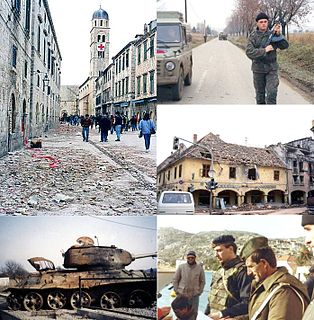
The 1991 Yugoslav campaign in Croatia was a series of engagements between the Yugoslav People's Army (JNA), the Yugoslav Navy and the Yugoslav Air Force, and the Croatian National Guard (ZNG) then the Croatian Army (HV) during the Croatian War of Independence. The JNA was originally deployed in order to preserve Yugoslavia, and the initial plan of the campaign entailed the military occupation of Croatia and the removal of the Croatian leadership elected in 1990. The JNA intervention was the culmination of its involvement in the confiscation of weapons from Croatia's Territorial Defence, and in the Croatian Serb revolt that had begun in August 1990. From that time, the JNA had been frequently deployed to form a buffer zone between the insurgents and the ZNG or the Croatian police. In effect, these JNA buffer zones often secured the territorial gains of the insurgents and led to an increasingly hostile relationship between the JNA and Croatia. The JNA campaign plan was amended shortly before the campaign to include the relief of JNA barracks besieged by the ZNG. The besieging and subsequent capture of several JNA facilities allowed Croatia to arm its previously poorly equipped military and to equip new recruits.
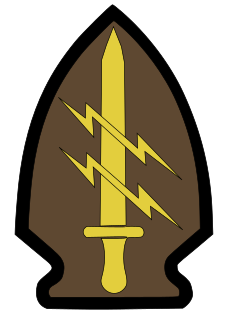
The order of battle of the Croatian (SJP) Specialne Jedinice Policia in English: The Special Police Unit in 1991–1995 included up to 30 individual special forces units subordinated to the Ministry of the Interior. The special police was created around the Ministry of the Interior's existing airborne special forces unit following an open revolt of the Croatian Serbs against the Government of Croatia in August 1990. It further developed with the increasing involvement of the Yugoslav People's Army in the conflict, supporting the Croatian Serbs. The conflict escalated into the Croatian War of Independence in 1991. The special police took part in the first clashes of the war in Pakrac and at the Plitvice Lakes. As Croatia had no army, the 3,000-strong special forces became the country's most effective fighting force.

The Battle of Logorište was fought east of Duga Resa and south of Karlovac, Croatia, from 4–6 November 1991 during the Croatian War of Independence, between the Croatian National Guard and the Yugoslav People's Army. The ZNG placed the JNA-held Logorište barracks under a blockade as part of the countrywide Battle of the Barracks, which aimed to pin down JNA units isolated in their bases and force them to surrender weapons and ammunition to the ZNG. However, the JNA garrison broke out from the besieged barracks with part of its stored equipment before the ZNG claimed the vacant base. The breakout was supported by JNA units and SAO Krajina units deployed to lift the blockade of the barracks and other JNA garrisons in Karlovac. A battle ensued as the ZNG attempted to contain advancing JNA units, ending with a ceasefire signed in The Hague.
The Zrinski Battalion was a special forces unit of the Croatian National Guard and later of the Croatian Army established in Kumrovec on 18 May 1991, during the Croatian War of Independence. The unit drew personnel from the special police forces and a former French Foreign Legion troops serving as its core. The battalion was set up and initially commanded by Ante Roso, while Major Miljenko Filipović took over as the commanding officer in August.

The siege of Varaždin Barracks, also referred to locally as Varaždin's days of war, was the blockade and capture of the Yugoslav People's Army (JNA) barracks and other facilities in and around the city of Varaždin during the Croatian War of Independence. The blockade began on 14 September 1991, quickly escalated into fighting, and ended on 22 September with the surrender of the JNA garrison. It was part of the Battle of the Barracks—an effort by Croatian armed forces to isolate JNA units based at barracks in Croatia, or capture the barracks to provide arms for Croatia's nascent army.

The siege of Bjelovar Barracks, also known by the codename Operation Bilogora, was the blockade and capture of the Yugoslav People's Army (JNA) barracks and other facilities in and around the city of Bjelovar, a part of the JNA 32nd (Varaždin) Corps, during the Croatian War of Independence. A general blockade of the JNA facilities in Croatia was ordered on 14 September 1991, and it continued until 29 September when the JNA garrison was captured by Croatian forces. Its capture occurred one week after the bulk of the 32nd Corps surrendered. It was part of the Battle of the Barracks—an effort by Croatian armed forces to isolate JNA units based at barracks in Croatia, or capture the barracks to provide arms for Croatia's nascent army.

The Battle of Kusonje was a two-day clash fought in the village of Kusonje near the town of Pakrac on 8–9 September 1991, during the Croatian War of Independence. The battle was initiated when a platoon of the Croatian National Guard was ambushed by Croatian Serb forces while conducting a reconnaissance patrol. The ZNG deployed reinforcements to extract the ambushed platoon, but failed to reach them. The surviving members of the platoon held out until they ran out of ammunition and surrendered only to be killed by their captors and buried in a mass grave.
The Croatian Special Forces Command is a unit of Croatian Armed Forces, subordinate to the General Staff of the Armed Forces, whose mission is to ensure the combat readiness of the special forces for operations in defense of the territorial integrity, sovereignty and independence of the Republic of Croatia and to participate in NATO and coalition-led operations.
The Croatian River Battalion is an inland brown water naval unit of the Croatian Army headquartered at the Vrbik Barracks in Osijek, Croatia. Located inland on the Drava River, the River Battalion is a component of the Croatian Land Forces and was established in 2007.









